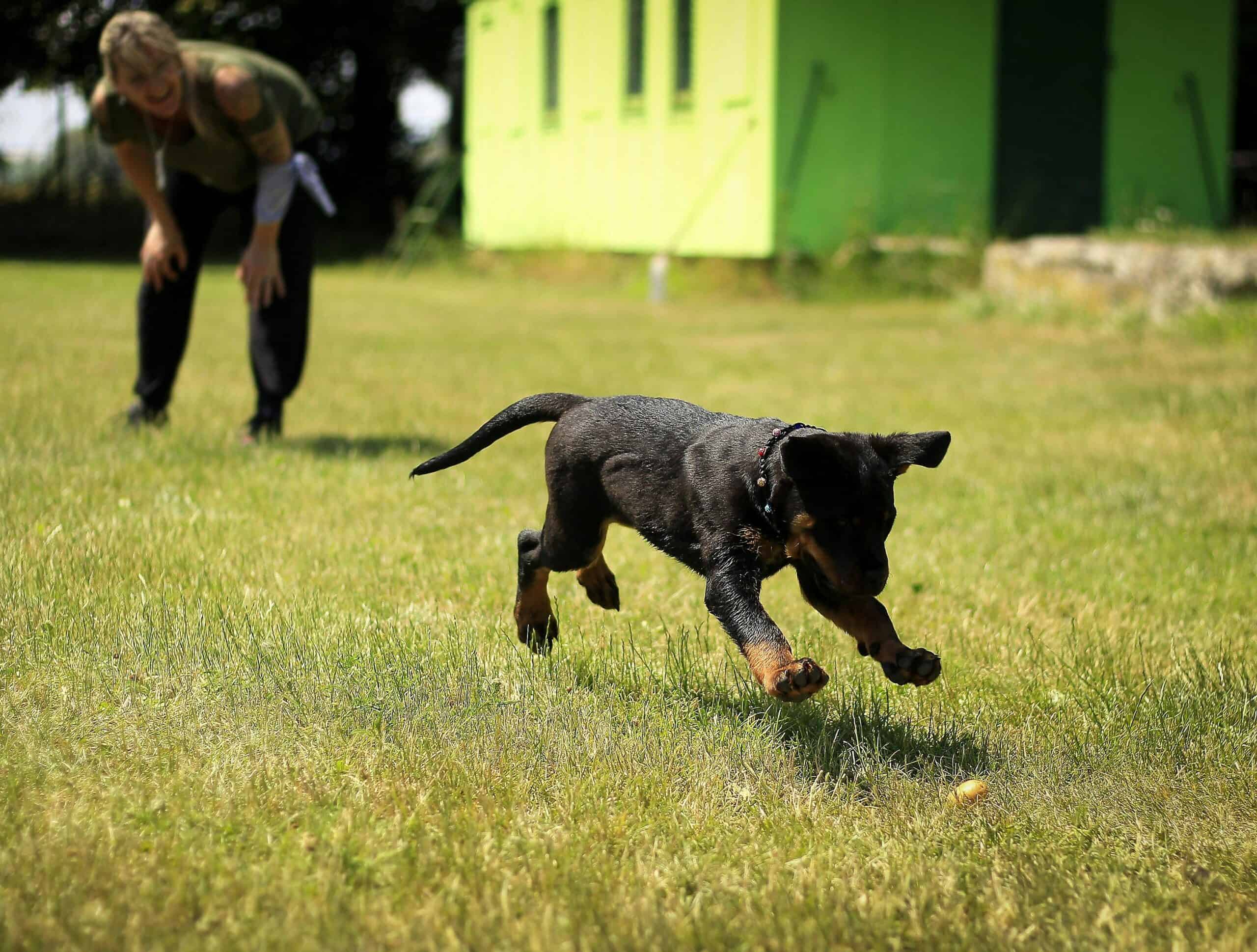The Basic Commands All Dogs Should Know
Posted by Lora Shaw on November 18, 2024

A Brief Overview of Basic Dog Commands
- Core commands – Teaching your dog the commands “sit,” “stay,” and “come” are fundamental. They promote control, ensure safety, and guarantee your pup will return if called.
- Easiest commands to teach – Commands such as “down,” “paw,” “heel,” “no,” “leave it,” “drop it,” “fetch,” “sit pretty,” and “high five” are generally easier for dogs to learn due to alignment with their natural behaviors.
- More challenging commands to teach – Tricks like “roll over,” “play dead,” “heel,” “speak,” “spin,” “back up,” and “crawl” require higher levels of coordination, focus, and repetition, making them more challenging for dogs.
- Training tips – Effective training involves starting with basic commands, combining verbal and hand cues, practicing in short sessions, and gradually introducing distractions.
Teaching your dog commands is one of the most rewarding aspects of dog ownership. By introducing essential commands and also trying more difficult ones, you help your dog understand basic rules and improve their behavior, all while creating a stronger bond between the both of you.
Whether you’re starting with simple commands like “sit” and “stay” or working up to more advanced ones, training your dog to understand commands helps build obedience, trust, and confidence. Explore everything you need to know on dog commands, including helpful tips for making training effective and enjoyable for both you and your furry friend!
Teaching Your Dog Commands: Essential Ones All Pups Should Know
No matter the breed, age, size, or color, there are three essential commands that all dogs should know. These commands not only help to set the foundation for teaching your dog other commands but provide essential control and safety measures that your dog needs.
Three important dog commands that you should consider teaching first include:
- Sit – This command promotes impulse control and serves as a foundation for other commands, making it easier to manage your dog in various situations.
- Stay – This command prevents your pup from rushing into unsafe situations, like running into traffic or approaching anything hazardous. It also reinforces patience and self-control.
- Come – This command ensures that your dog will return to you, even in potentially dangerous situations, such as when they are distracted or off their leash.
The Easiest and Hardest Commands for Your Dog to Learn
As you begin training your dog to understand commands, it’s helpful to know which commands are easier to teach and which ones may take a bit more time and effort to master.
In addition to “sit,” “stay,” and “come,” the easiest dog commands to master, thanks to their simplicity and rate of success, as well as their ability to quickly engage your dog’s attention, include:
- Down
- Paw
- Heel
- No
- Leave it
- Drop it
- Fetch
- Sit pretty
- High five
Due to the following requiring a higher level of coordination, focus, and repetition, the more challenging commands for your dog to learn include:
- Roll over
- Play dead
- Heel (off-leash)
- Speak
- Spin
- Back up
- Crawl
10 Tips and Tricks to Teach Your Dog Commands at Home
Using the right techniques can help ensure your dog learns their new commands quicker and with more confidence. Check out these ten tips and tricks we’ve compiled to make training your dog to understand commands easier and more effective!
1. Start with the Basics
As previously mentioned, begin by introducing the more basic dog commands first. This helps build a foundation for learning more complex commands and will set the tone for future sessions.
Remember that these commands are simple, yet powerful!
2. Combine Both Verbal Cues and Hand Cues
Try to pick one clear word for each command and stick with it. For example, always say “sit” when you want your pup to sit, without changing it to “sit down” or “sit, please” later on.
Additionally, dogs are great at reading your body language! Try to pair your verbal cues with a hand gesture. For instance, when saying “sit,” raise your hand with a flat palm above their head.
3. Practice in Short and Frequent Sessions
Be sure to keep each training session brief but consistent. A good schedule to go by includes 5-10 minutes of focused practice on teaching dog commands, then repeating the session two to three times per day.
This is the best way to teach your dog commands without overwhelming them.
4. Reinforce Immediately After the Command
When your dog obeys a command, use positive reinforcement to reward them immediately. Using praise, treats, or playtime can help them connect the desired behavior with the reward and reinforces the learning process.
5. Add Duration to Commands
Once you have mastered a basic dog command like “sit,” begin to add in duration time.
For example, once they sit, try to wait a few seconds before rewarding them, then gradually increase the time before they get their reward. This teaches your pup patience and focus, setting them up for success when learning the next command!
6. Only Introduce One Command at a Time
Avoid overwhelming your dog by focusing on teaching just one command at a time. Once they consistently respond to the command without hesitation, feel free to move on to the next one.
This gradual approach ensures that there aren’t too many commands for your dog to learn at once, making learning more manageable and fun for them.
7. Practice in Different Locations
To help your dog generalize the command, practice it in different areas of your home and yard. This helps your pup learn to follow the command in various settings, something that is especially beneficial for when you need to implement the command outside of your home or specific training space.
8. Use a Calm Tone
When teaching your dog commands, speak in a calm, clear, and confident tone, because dogs are sensitive to the tone of your voice. A gentle, but assertive voice helps them feel secure so they are more likely to respond positively.
Some of the things you should avoid to keep a calm tone include:
- Raising your voice
- Shouting
- Sounding frustrated
9. Gradually Introduce Distractions
Once your dog consistently obeys a command in a calm setting, it’s time to increase the challenge. Introducing distractions helps your dog learn to focus and respond to your commands, even in more public environments.
Some distractions to consider introducing include:
- Other people being in the room
- Outdoor noise, such as the sounds of cars passing by
- Other pets being nearby
- Toys or treats placed within sight
- Background noises, like music or the TV
10. Be Patient
Patience is crucial when teaching your dog new commands. Every dog learns at their own pace, so be sure to not rush the process or get frustrated.
If your dog doesn’t get everything right away, remain positive and keep practicing! Negative reinforcement can confuse or frighten your dog, while hurting your progress.
Let Us Assist in Training Your Dog to Understand Commands
Here at Pet Palace, we specialize in teaching your dog commands that promote better behavior and safety. Our expert trainers are here to help you and your dog master a variety of commands, from the basics to more advanced skills, all while using positive reinforcement techniques.
Our dog training services include:
- Polite Puppy Program – Basic obedience and socialization for puppies
- Basic Adult Program – Focused training for adult dogs to learn essential commands
- Advanced Adult Program – Customizable training for pups that are 8 months or older
We currently offer dog training services at our Pittsburgh, Columbus, Cary, and West Chester locations. Simply book your pup’s reservation to begin the training process!
Contact Pet Palace Today!
If you have any questions about teaching your dog commands, or need additional training assistance, don’t hesitate to reach out to our team of professionals. We’re excited to assist you and your furry friend throughout this learning process!

Categories: Dog Training, Dogs, Tips for Your Pets
Archives
Recent Articles
Categories
Monthly Archive
- April 2025
- March 2025
- February 2025
- January 2025
- December 2024
- November 2024
- October 2024
- September 2024
- August 2024
- July 2024
- June 2024
- May 2024
- April 2024
- March 2024
- February 2024
- January 2024
- December 2023
- November 2023
- October 2023
- August 2023
- July 2023
- June 2023
- May 2023
- April 2023
- March 2023
- February 2023
- January 2023
- December 2022
- November 2022
- October 2022
- August 2022
- July 2022
- June 2022
- April 2022
- March 2022
- February 2022
- November 2021
- October 2021
- November 2020
- September 2020
- July 2020
- March 2020
- January 2020
- November 2019
- September 2019
- July 2019
- March 2019
- January 2019
- December 2018
- November 2018
- October 2018
- August 2018
- July 2018
- June 2018
- May 2018
- April 2018
- March 2018
- February 2018
- January 2018
- December 2017
- November 2017
- October 2017
- September 2017
- August 2017
- July 2017
- June 2017
- May 2017
- April 2017
- March 2017
- February 2017
- January 2017
- December 2016
- November 2016
- September 2016
- August 2016
- July 2016
- June 2016
- May 2016
- April 2016
- March 2016
- February 2016
- December 2015
- November 2015
- October 2015
- September 2015
- August 2015
- July 2015
- May 2015
- March 2015
- February 2015
- January 2015
- December 2014
- November 2014
- September 2014
- August 2014
- July 2014
- June 2014
- May 2014
- April 2014
- March 2014
- February 2014
- January 2014
- December 2013
- November 2013
- October 2013
- September 2013
- August 2013
- June 2013
- May 2013
- March 2013
